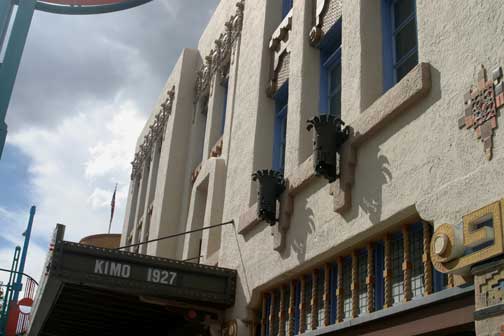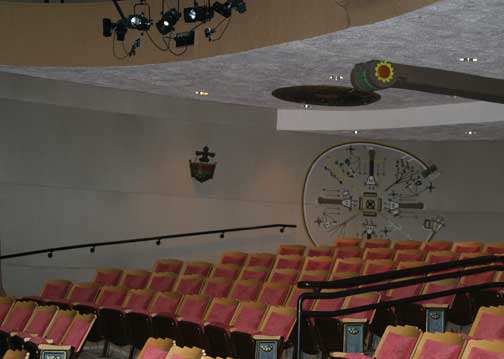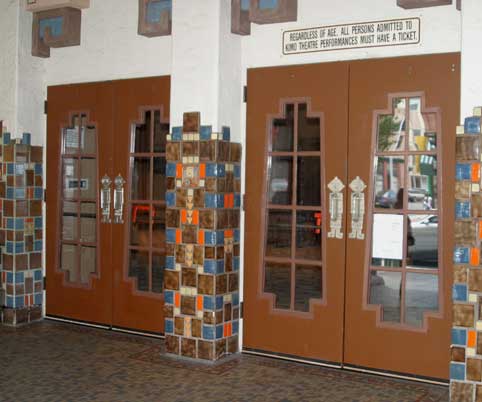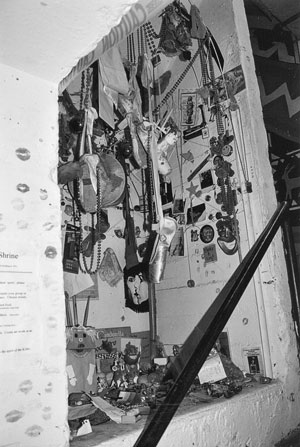
ABOUT "KiMo Theater"
The ghost said to reside therein, that of a six-year-old boy, has been the subject of dozens of newspaper and magazine articles, book chapters, and even a few investigations by local ghost hunter groups. It’s a rare Halloween in Albuquerque when one or more news outlets doesn’t carry some mention of the KiMo ghost. For such a public and well-known ghost story, it had received very little skeptical scrutiny until 2007,when I decided to look into the case, joined by Albuquerque writer Mike Smith.
The story of the KiMo ghost begins with a tragedy on August 2, 1951. About a thousand people were in the theater to see an Abbott and Costello film when a water heater exploded into the lobby. When the dust and chaos had settled, eight people lay fallen; most seriously injured was Robert (Bobby) Darnall Jr., a six-year-old who died from his wounds. Bobby was laid to rest, and life went on after the KiMo soon reopened. No one thought much more about Bobby or the explosion until a few decades later—when Bobby returned from the grave.
Bobby’s Return
this photo of bobbay darnall was taken from the albuquerque journal coverage of the kimo explosion.
This photo of Bobbay Darnall was taken from the Albuquerque Journal coverage of the KiMo explosion.
Bobby Darnall returned in a most spectacular fashion. As the KiMo’s longtime technical manager, Dennis Potter, described, “It was just before Christmas, and the New Mexico Repertory Theater Company did A Christmas Carol.” The director, Andrew Shea, noticed some doughnuts strung up against the brick wall at the back of the stage, supposedly left as an offering to the ghost. Shea ordered them removed, thus angering Bobby’s ghost.
Potter, who worked the production and was there that night, says that “about ten or fifteen minutes into the show, weird things started going wrong. People were forgetting their lines, people were tripping and falling on stage, odd pieces of equipment would fall from the ceiling, light bulbs exploded. Electrical cables fell down . . . light gels came off and fluttered down during dramatic moments. . . . Windows and doors on the set were either not opening, or were opening when they weren’t supposed to. It was just really weird. They almost literally didn’t get through the show, there were so many disruptions.”
Finally the show ended. According to Potter, the director replaced the doughnuts to appease Bobby and the next show went off without a hitch. From then on, doughnuts were left for Bobby as an offering for a successful show; some years ago they were moved to a small shrine near the dressing rooms. These days, for health reasons, the doughnuts have been replaced by a collection of other offerings for the boy ghost, ranging from toys to theater tickets to ballerina shoes.
According to several sources (including Garcez 1994), the doomed Christmas Carol production was held on December 25, 1974. Others claim that Bobby continues to haunt the KiMo and has in fact ruined other performances since then. Writer Scott Johnson of the ghost-themed Web site DreadCentral.com claims, “For a period of time, it seemed that not one performance went off without some type of disaster. . . . Sightings of Bobby are continuous, year round” (Johnson 2007).
The story of the KiMo Theater has all the elements of a good ghost story, including the tragic death of a young boy and unexplained happenings. Yet all the reports—absent further investigation—are simply stories and anecdotes, not hard evidence.
There are a few people who claim to have found real evidence of Bobby’s ghost in the KiMo. They are the Albuquerque ghost hunting group New Mexico Paranormal Investigations (NMPI). The NMPI team searched for evidence of Bobby or other spirits using electromagnetic field (EMF) detectors, dowsing rods, thermometers, and other equipment. During their investigation, they reported finding “anomalous EMF energy,” a “wisp of energy,” and so on, as well as taking photographs they claim are of Bobby’s ghost.1
. . . But Is It True?
this headline from the albuquerque journal details the 1951 explosion at the kimo that killed young bobby darnall.
This headline from the Albuquerque Journal details the 1951 explosion at the KiMo that killed young Bobby Darnall.
At first glance, and taken together, the evidence that Bobby Darnall haunts the KiMo Theater seems impressive. Hundreds of eyewitnesses seemingly saw unexplained phenomena during the ruined Christmas production; ghost experts confirmed the existence of something supernatural at the KiMo, complete with “anomalous” photos. But one dictum of skeptical investigation is “The devil is in the details.” In this case, the ghost—or lack thereof—is in the details.
The account of the disastrous production is important in understanding the KiMo ghost story for several reasons. It is the first time that the ghost of Bobby Darnall was linked to mysterious occurrences at the KiMo. Perhaps more important, it is something tangible, something that can be verified. Most of the “evidence” for ghosts consists of odd feelings, ambiguous photos, and occasional sightings—things that can’t really be examined or tested. But the unexplained phenomenon of exploding lights, mysterious falls, and objects moving on their own—witnessed by thousands of people on several occasions—is much closer to hard evidence.
the shrine to bobby’s ghost is located backstage at the kimo theater.
The shrine to Bobby’s ghost is located backstage at the KiMo Theater.
Something—whether it was Bobby’s ghost or some other mysterious force—ruined the production of A Christmas Carol on Christmas Day 1974.
Or did it?
The first step in unraveling a mystery is verifying the date. As it turns out, Bobby’s ghost could not have ruined a play at the KiMo on Christmas Day 1974. A newspaper archive search revealed that the KiMo was an adult theater at that time, and patrons that day saw a pornographic film called Teenage Fantasies. If Bobby was present that day, the early ’70s porn was probably more disturbing to the child ghost than the lack of doughnuts.
Potter dismissed the claims that there had been several ruined shows, saying there had only been one and that it was not in 1974 but instead in the late 1980s or early 1990s (his memory was hazy not only about the year but the decade). With some detective work, Mike and I narrowed down the year to December 1986 and then contacted others involved with that production of A Christmas Carol. I spoke to Steve Schwartz, the actor who played Bob Cratchet. I asked him what he remembered about that fateful night.
“It went great, it was a wonderful performance,” he said.
A wonderful performance? With all the unexplained problems? How could he have forgotten such an infamous event? I elaborated, hoping to jog his memory. “The story goes that there was a performance of A Christmas Carol—in fact it was one of the ones you played in—that was ruined by mysterious phenomena: the actors forgot their lines, there were exploding lights, missing props, and basically everything that could go wrong went wrong.”
Schwartz replied, “That sounds like good copy, but I can’t corroborate any of that. I don’t remember any problems like that or any problems with the show.”
I hung up the phone, trying to understand why the technical manager and the lead actor in the same play had two completely opposite memories of the show. Of course, people’s memories change over time, and though Mr. Schwartz didn’t recall problems with the play, someone else might.
To get a third eyewitness account, Mike contacted Andrew Shea, who directed the play and whose dismissive doughnut disposal allegedly led to the ruined performance. Shea spent eight years directing plays at the KiMo from 1984 to 1991. He also disputed Potter’s recollection of the disaster: “I don’t remember it being a disaster in any way,” he said. Furthermore, according to Shea, the story of him taking down the doughnuts and then replacing them after the disastrous performance never happened. He also discredits other stories about ongoing strange occurrences at the KiMo due to Bobby or any other ghost: “There were no events during my eight years there that didn’t have mundane explanations. . . . I don’t recall anything supernatural or out of the ordinary happening.”
So the play’s main actor and the director both discredit the ghost story, as did numerous others in the production. Dennis Potter is literally the only person who remembers the ruined play. A final nail in the coffin came from newspaper accounts of the play—or, more precisely, the lack thereof. We searched newspapers for reviews. Surely such a mysterious and infamously disastrous performance would have been noted at least in passing in the Albuquerque Journal or the Albuquerque Tribune. The reviews were positive, and not one mentioned actors falling or tripping, exploding lights, or any ghostly activities. All the evidence points to one inescapable conclusion: The ruined play—the very genesis of the KiMo ghost story—simply did not occur; it is but folklore and fiction.
kimo technical director dennis potter shows the author where the theater’s boiler exploded.
KiMo technical director Dennis Potter shows the author where the theater’s boiler exploded.
Spawning the Story
Where does this leave Dennis Potter and the countless ghost articles his tale spawned? Potter is not a liar nor is he crazy; he simply did something we all do from time to time: he misremembered. Decades of psychology studies show that human memory is remarkably fallible. The brain is not, as many suppose, a sort of tape recorder that accurately preserves what we experience. Instead, memories change over time. Until we are confronted with evidence to the contrary, we will continue to confidently believe our memories.
Psychology helps explain how Potter’s faulty memory could create a ghost story. But hundreds of sources, from Antonio Garcez to Albuquerque ghost hunters to local television reports and Web sites, repeated the story of Bobby and the doomed show. How could so many accounts have gotten it wrong? The simple answer is that Dennis Potter is the source of virtually all the information; the journalists, writers, and “investigators” repeated the stories, never bothering to independently verify his account.
a close inspection of photos and news accounts reveals that the stairwell and railing were intact and undamaged in the explosion.
A close inspection of photos and news accounts reveals that the stairwell and railing were intact and undamaged in the explosion.
One difficulty with information on the KiMo ghost (as with most paranormal topics) is the tendency for many writers on the subject to simply copy information from one source to another without checking any facts. The problems range from shockingly sloppy research to outright plagiarism.2
Ghostly Evidence
With some skeptical investigation, the story of Bobby Darnall’s ghost collapses like a haunted house of cards. But an obvious question arises: What about the ghost hunters who claimed to find evidence of Bobby’s ghost? What phenomena at the KiMo are they interpreting as evidence of the paranormal?
To answer this, some background on ghosts and ghost hunting is helpful. There is no evidence that ghosts exist, much less that the tools the ghost hunters use (dowsing rods, pendulums, electromagnetic field detectors, etc.) actually detect ghosts. Many ghost hunters seem unaware of this fact or willfully ignore it. As with the story of the doomed play, the “ghostly evidence” evaporates under a little critical thinking and close examination. Almost every part of the ghost hunters’ investigation is scientifically invalid and/or factually wrong.
Aside from a few “anomalous readings,” one of the NMPI’s favorite pieces of evidence for ghosts is something called an orb. These are “unexplained” round or oval white shapes that appear in photos. There is not one blanket cause for all orbs; many things can create the phenomena, including insects, reflected flashes, and dust. Orbs may seem otherworldly because they appear only in photographs and are usually invisible to the naked eye. They are often unnoticed when the photo is taken; it is only later that the presence of a ghostly, unnatural, glowing object is discovered, sometimes appearing over or around an unsuspecting person. To those unaware of alternative explanations, it is no wonder that orbs will spook many people. (For more on orbs, see Radford 2007, Nickell 1994, and Biddle 2007).
The ghost hunters made another mistake. The NMPI Web site has a short write-up of their investigation, and one photograph shows an orb at the top of the KiMo’s stairs; the caption reads, “Note orb at location of Bobby’s death.”
However, Bobby Darnall did not die on the stairs as the NMPI investigators claim. A close inspection of photos and news accounts reveals that the stairwell and railing were intact and undamaged in the explosion. According to a photo and caption on page 2 in the August 3, 1951, Albuquerque Journal, “Balcony stairs directly over the heaters were undamaged.” Since the stairs above the heater were “undamaged,” it’s virtually impossible that Bobby was on the stairs (much less on the landing where the “ghost photo” was taken) when the explosion occurred. Had Bobby been on the stairs, the concrete stairs themselves would have shielded him from the blast underneath.
instead of the kimo’s supposedly spiritually ruined performance of a christmas carol, this advertisement from the christmas 1974 albuquerque journal shows that the venue was instead an adult theater.
Instead of the KiMo’s supposedly spiritually ruined performance of A Christmas Carol, this advertisement from the Christmas 1974 Albuquerque Journal shows that the venue was instead an adult theater.
The ghost hunters are even wrong on a more basic point: not only didn’t Bobby Darnall die on the staircase where his supposed ghost was photographed, he didn’t even die at the KiMo theater! According to the August 2, 1951, Albuquerque Journal, Bobby Darnall was alive when he left the KiMo: “Police said the boy had a faint pulse when picked up in the theater lobby, but he was dead on arrival at St. Joseph’s Hospital.” So Bobby actually died in an ambulance somewhere on the streets of downtown Albuquerque.
Any credibility the ghost hunters may have had vanishes quickly under the mountain of basic errors, mistaken assumptions, and unchecked facts. Perhaps most troubling, ghost hunting organizations portray themselves as expert authorities on ghosts and the paranormal. They sell books, give lectures, and charge money for seminars, supposedly teaching clients how to conduct ghost investigations.
Just as Dennis Potter did not intentionally create the story of the KiMo ghost, the ghost hunters did not intentionally hoax or mislead anyone. Their “evidence” is simply a series of errors and mistaken assumptions. To be fair, the low level of science and investigation is actually typical for amateur ghost hunter groups. They are staffed by sincere people who have good intentions but a very poor understanding of investigation, research, or scientific methods.
When facts are checked and mistakes corrected, the inescapable conclusion is that there is simply no evidence of a ghost at the KiMo Theater. Ultimately, the KiMo ghost story is neither a lie nor a hoax—but nor is it true. Overactive imaginations, factual errors, and mistakes, combined with standard theater ghost lore and some misguided ghostbusters, created the KiMo ghost. The story was told and retold, hashed and rehashed, with each iteration adding or omitting details without anyone bothering to check the facts until finally a ghost was created.
The KiMo ghost has been the subject of local lore for at least a decade. While some may mourn the passing of a good ghost story, no harm can come from finding out the truth. In fact, the story of Bobby Darnall as the KiMo ghost has pestered and haunted the Darnall family for decades. His sister and brother feel exploited by the story and do not appreciate the fictional claims that their beloved brother is eating doughnuts or ruining performances at the KiMo Theater. Only when the KiMo story is repeated as fiction, not fact, can the memory of little Bobby Darnall truly rest.
423 Central Avenue Northwest, Albuquerque, New Mexico, 87102
(505) 768-3522
Ghost Tours
Suitable for all guests and families (HALLOWEEN FUN)
Join our email list to receive discount offers and updates.
LEAVE A QUICK REVIEW
SKULL METER - RATE THIS HAUNT
PHOTOS & VIDEOS
KiMo Theater VIDEOS
KiMo Theater PHOTOS
SOCIAL FEEDS


REVIEW















